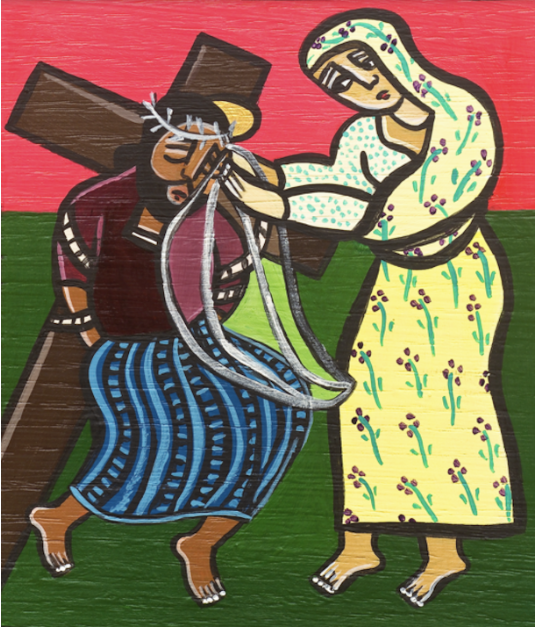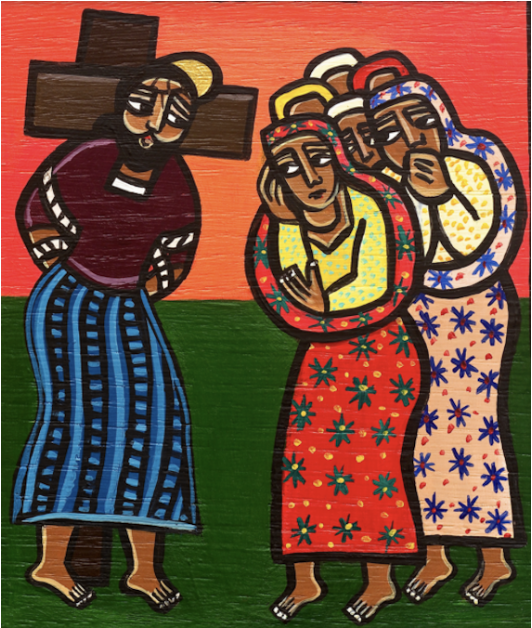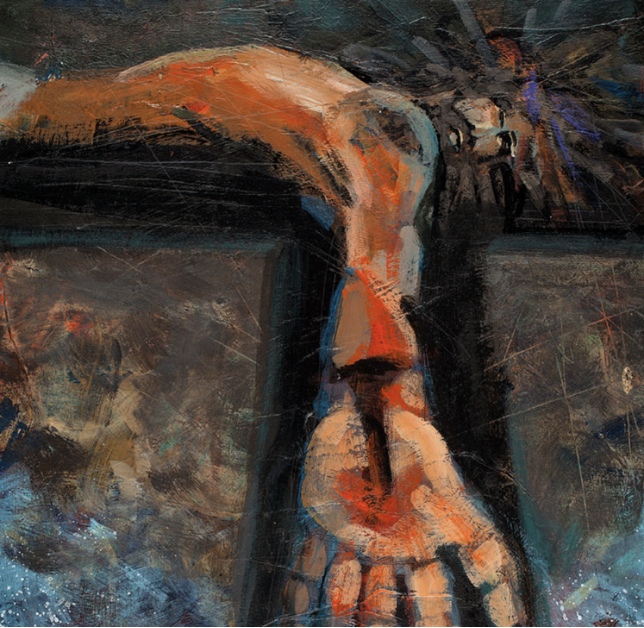Stations of the Cross
An Easter Meditation
The Stations of the Cross are a series of images representing the final moments of Jesus’ passion and have been used by centuries to aid Christian devotion and contemplation. In this meditation, each station begins with a reading, followed by a reflection and then a prayer.
Station One: Jesus Is Condemned to Death
Again, the high priest began to ask him, and said to him, ''Are you the Christ, the Son of the Blessed One?" And Jesus said to him, "I am. And you shall see the Son of Man sitting at the right hand of the Power and coming with the clouds of heaven." But the high priest tore his garments and said, "What further need have we of witnesses? You have heard the blasphemy. What do you think?" And they all condemned him as liable to death.
In the first station, we see an innocent man condemned to death due to injustice, false accusation, and the vicious frenzy of a mob. And Christ shows us that avoiding condemnation at all cost cannot be our goal. Jesus defied the authorities of his time, teaching a higher way. We too must be willing to be condemned for our witness. And Jesus taught us how to respond to: with dignity, head unbowed, unyielding.
Imagine the pain to hear the people of Jerusalem, the people you have healed and taught, baying for your death.
May we each face our own suffering, humiliations, and rejections with dignity and strength, trusting in God to deliver us.
Station Two: Jesus Carries His Cross
And Pilate said to the Jews, "Behold, your king!" But they cried out, ''away with him! Away with him! Crucify him!" Pilate said to them, "Shall I crucify your king?" The chief priest answered, "We have no king but Caesar." Then he handed him over to them to be crucified. And so they took Jesus and led him away, bearing the cross for Himself.
Where once Jesus’s arms held children, now they held the instrument of his death. Yet he willingly bore the heavy burden in order to make ours light. The first tree of life was planted in Eden. The second would be planted in Golgotha, producing fruit unto eternal life.
May we each carry the crosses we have been given with faith that our labors will be redeemed for good.
Station Three: Jesus Falls the First Time
And the soldiers plaited a crown of thorns, and put it on his head, and arrayed him in a purple robe; they came up to him, saying, “Hail, King of the Jews!” and struck him with their hands.
Jesus, the greatest of all, fell into the mud on a garbage-strewn street of a backwater town. People surrounded him mocking and scorning. The public appearance was one of absolute failure. But perception and reality can diverge. In falling, Jesus was already beginning to rise and carry us with him.
May we remember in our failures that Christ is with us there, too, waiting to help us back up.
Station Four: Jesus Meets His Afflicted Mother
Now there were standing by the cross of Jesus his mother and his mother's sister, Mary of Cleopas, and Mary Magdalene. When Jesus, therefore saw his mother and the disciple standing by, whom he loved, he said to his mother, "Woman, behold your son." Then he said to the disciple, "Behold, your mother." And from that hour the disciple took her into his home.
Throughout all of his ministry, Jesus’ mother was a constant. Hers was a proclamation of presence. She shows unwavering, unconditional love. She braved social convention, reputation, accusations, threats to preserve and cherish her miraculous son. And on his way of sorrows, in his final moments, Jesus found comfort and strength in his mother, the first disciple.
May we, like Mary, love through suffering and stand beside those in need of our presence.
Station Five: Simon of Cyrene Helps Jesus to Carry His Cross
And when they had mocked Jesus, they took the purple cloak off and put his own clothes on him, and they led him out to be crucified. Then they forced a certain passer-by, Simon of Cyrene coming from the country, to take up his cross. They brought Jesus to the place called Golgotha a name meaning 'the place of the skull.'
We don’t know why the Romans chose Simon to help Jesus with the cross. I like to believe it is because he expressed sympathy with Jesus. That instead of turning away from suffering, or accepting injustice as the natural way, he opened his heart and became involved. And that small opening may have led Simon to a transformation of everything in his life.
May we help carry one another’s crosses and entangle ourselves in the messy, glorious lives of those around us.
Station Six: Veronica Wipes the Face of Jesus
"Lord, when did we see you hungry, and feed you; or thirsty, and give you drink? And when did we see you a stranger, and take you in; or naked, and clothe you? Or when did we see you sick, or in prison, and come to you?" And answering the king will say to them, "Amen, I say to you, as long as you did it for one of these, the least of my brethren, you did it for me."
According to tradition, Veronica was a woman who, out of sympathy, stepped out of the crowd and gave Jesus her veil to wipe his forehead. It was a small act of comfort, yet when Jesus returned the veil the image of his face was miraculously captured on it. Perhaps this story suggested that when we serve one another we can see the face of God.
May our hearts always beat in sympathy with those in need.
Station Seven: Jesus Falls the Second Time
It was our weaknesses that he carried, our sufferings that he endured, while we thought of him as stricken, as one struck by God and afflicted. But he was pierced for our offenses, crushed for our sins; upon him was the punishment that makes us whole, by his stripes we were healed. We had all gone astray like sheep, each following his own way; but the Lord laid upon him the guilt of us all.
The call to holiness is not easy. We shall fall and rise, rise and fall, over and over and again and again. Our path is not linear, but zig-zag. Yet we can, with the grace of God, always rise again and move toward the light.
May we forgive ourselves when we fall and rise again into new life.
Station Eight: Jesus Meets the Women of Jerusalem
There was following Jesus a great crowd of people, and among them were some women who were bewailing and lamenting him. Jesus turning to them said, ''Daughters of Jerusalem, do not weep for me, but weep for yourselves and for your children."
Once popular and praised, Jesus has become mocked and scorned. An outcast, a criminal, a nobody. His friends and followers appeared to abandon him, afraid of the mob. But a rag-tag group of women had the sensitivity to weep for this good man, unjustly condemned. These women show us how to step forward with courage to stand with those in need.
May we have eyes to see the truth about each person, the divinity within.
Station Nine: Jesus Falls a Third Time
I lie prostrate in the dust; give me life according to your word. I declared my ways and you answered me; teach me your commands. Make me understand the way of your precepts, and I will meditate on your wondrous deeds. My soul weeps for sorrow; strengthen me with your words.
With each heavy step forward, Jesus’ body was approaching its limit. His knees buckle, then falter; He falls again into the Jerusalem dirt. His breathing is heavy and labored, his muscles cramped. The pain is too much, but he rises anyway, moved forward in the knowledge that this is the way he can become the way for all.
May we never lose hope, even when all seems lost.
Station Ten: Jesus Is Stripped of His Clothes
They gave Jesus wine to drink mixed with gall; but when he had tasted it, he would not drink. Then after they had crucified him they divided his clothes, casting lots to fulfill what was spoken through the prophet, "They divided my clothes among them, and upon my garments they cast lots."
It is through our clothing that we signal to the world our self-identity, our status, our power. Jesus willingly abandons every external symbol of success in order to reveal to us that internal transformation is the true path to joy and salvation.
May we always clothe the naked, not our ego.
Station Eleven: Jesus Is Nailed to the Cross
When they came to Golgotha, the place called the Skull, they crucified Jesus and the robbers, one on his right and the other on his left. And Jesus said, "Father, forgive them, for they do not know what they are doing."
When Jesus is nailed to the cross, we are called to have faith that a loving God is present even in the deepest darkness, even in the presence of unfathomable cruelty.
May we do all things in remembrance of the blood of the Son, which was shed for us.
Station Twelve: Jesus Dies on the Cross
It was now about the sixth hour, and there was darkness over the whole land until the ninth hour. And the sun was darkened, and the curtain of the temple was torn in the middle. Jesus cried out with a loud voice and said, "It is finished. Father, into your hands I commend my spirit." Then, bowing his head, he died.
Jesus had been scourged, stripped, and crucified. But there was one pain, perhaps greater than those, that he seems not to have foreseen. The abandonment in his final moments of his father.
"Eloi, Eloi, lama sabachthani?"
"My God, my God, why have you forsaken me?"
Why did God withdraw his presence? Perhaps because to descend below all things required understanding that most exquisitely painful experience for humans: loneliness, isolation, rejection.And by fulfilling that ultimate descent, Jesus succors us with his holy friendship, a grace-full companion able to ascend all and carry us with him.
May we look to the cross, and live.
Station Thirteen: The Body of Jesus Is Taken Down from the Cross
When the soldiers came to Jesus, they saw that he was already dead so that they did not break his legs, but one of them opened his side with a lance, and immediately there came out blood and water. Joseph of Arimarthea, because he was a disciple of Jesus (although a secret one for fear of the Jews), besought Pilate that he might take away the body of Jesus. And Pilate gave permission.
All hope is lost, all dreams are dead, our beloved lies limp in our arms. Everything we thought we knew has turned to ash. In such moments, we must trust God that there might be another way for his purposes to come to pass. That sometimes in endings we find new beginnings.
May we tenderly hold the broken body of Jesus so that we can become the living body of Christ.
Listen to Stabat Mater, a 13th century hymn about Mary’s sorrow at the cross. The hymn is in Latin. See the English translation below.
At the cross her station keeping, stood the mournful mother weeping, close to Jesus at the last. Through her heart, his sorrow sharing, all his bitter anguish bearing, now at length the sword had passed. Oh how sad and sore distressed was that mother highly blessed, of the sole-begotten One! Christ above in torment hangs; she beneath beholds the pangs of her dying glorious Son. Is there one who would not weep, whelmed in miseries so deep Christ's dear Mother to behold? Can the human heart refrain from partaking in her pain, in that Mother's pain untold? For the sins of His own nation saw Him hang in desolation, all with bloody scourges rent. Bruised, derided, cursed, defiled, she beheld her tender child, till His Spirit forth he sent. O, though Mother, fount of love, touch my spirit from above, make my heart with thine accord. Make me feel as thou has felt; make my soul to glow and melt with the love of Christ our Lord. Holy Mother, pierce me through; in my heart each wound renew of my Saviour crucified. Let me share with thee his pain, who for all my sins was slain, who for me in torments died. Let me mingle tears with thee, mourning Him Who mourned for me, all the days that I may live. By the cross with thee to stay, there with thee to weep and pray, this I ask of thee to give. Virgin, of all virgins blest, O refuse not my request: let me in thy weeping share. Let me, to my latest breath, in my body bear the death of that dying Son of thine. Wounded with his every wound, steep my soul till it hath swooned in His very blood away. Be to me, O Virgin, nigh, lest in flames I burn and die, in that awful judgment day. Christ, when thou shalt call me hence, be Thy mother my defense, be Thy cross my victory. While my body here decays, may my soul Thy goodness praise, safe in Paradise with Thee. Amen.
Station Fourteen: Jesus Is Laid in the Tomb
Joseph of Arimathea took the body of Jesus, and wrapping it in a clean linen cloth he laid it in his new tomb, which he had hewn out of rock. Then he rolled a large stone against the entrance of the tomb and departed.
When Joseph left the tomb, he was probably weeping. Missing his friend and teacher. Worried about the safety of others of Jesus’ companions. But he had done what he could. He did his best. And such offerings are always enough. They are enough because Jesus always reaches out to fill our gaps.
And though they couldn’t see it yet, the friends of Jesus would soon discover the most beautiful truths possible:
That that tomb is full now, but soon, it will be empty;
That our lives hold pain now, but soon we’ll find healing;
That our hearts hold sorrow now, but soon we’ll find joy;
That now, we mourn, but soon we’ll sing hallelujah.
My prayer is that we will all seek to walk with Jesus, from Palm Sunday to Good Friday to Easter morning and shout Hosannah to his name now and forever.
Art by Laura James, Jen Norton, and Eric Gill.














































Thanks of sharing this tradition with us! E did it as a family and had some good reflection and conversation.
Thank you for this.